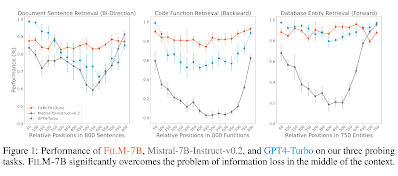Introduction
The rapid evolution of large language models (LLMs) has significantly advanced their capabilities in understanding and generating human-like text. However, a prevalent challenge persists—effectively utilizing long-context information, especially the crucial details embedded within the middle sections of the text. This blog post explores the groundbreaking research by Microsoft that introduces FILM-7B and INformation-INtensive (IN2) training, addressing the notorious "lost-in-the-middle" problem in LLMs.
The "Lost-in-the-Middle" Problem:
Identifying the Challenge:
LLMs have historically excelled in tasks involving short to medium-length texts but struggled with longer documents where critical information may be scattered across a vast text span. The "lost-in-the-middle" phenomenon describes the model's ineffectiveness in accessing and integrating details from the central parts of the text, which often leads to suboptimal decision-making and response generation in AI systems.
Microsoft's Hypothesis:
Research from Microsoft pinpoints the root of this issue as insufficient explicit supervision during the training phase, which inherently biases the models to pay more attention to the beginnings and endings of texts. This neglect of mid-text data is detrimental to the model's overall performance and applicability in real-world scenarios.
Introducing FILM-7B and IN2 Training:
Revolutionary Training Methodology:
To counteract the limitations of traditional training, Microsoft proposes the INformation-INtensive (IN2) training protocol. This innovative approach utilizes a synthetic long-context question-answering dataset designed to force the model to focus equally across the entire text span. The dataset is constructed from general natural language corpora, synthesized into long contexts ranging from 4K to 32K tokens by concatenating short segments of approximately 128 tokens each.
Training Dynamics:
FILM-7B leverages this dataset to undergo rigorous training where both contexts and corresponding questions are treated as direct instructions. This method enhances the model's capability to not only notice but also accurately process information spaced widely within the document.
Implementation and Impact:
VAL Probing for Comprehensive Evaluation:
A novel evaluation technique, VAL Probing, was developed to test the model’s efficiency across different types of data and retrieval patterns. This includes:
- Document Sentence Retrieval (Bi-Directional): Tasks the model with retrieving a specific sentence within a document-based context.
- Code Function Retrieval (Backward): Involves identifying the function name from a given code snippet.
- Database Entity Retrieval (Forward): Requires fetching the label and description for a specified ID within a structured dataset.
Groundbreaking Results:
The implementation of IN2 training and subsequent assessments through VAL Probing reveal that FILM-7B not only surpasses the baseline models but also demonstrates comparable, if not superior, performance against leading models like GPT-4-Turbo. The model's adeptness at handling diverse and complex tasks signifies a major leap forward in AI's operational efficacy.
Beyond the Technology:
Real-World Applications:
The enhanced capabilities of FILM-7B can transform numerous sectors by enabling more sophisticated data analysis, precise legal document review, comprehensive academic research, and advanced coding assistance tools.
Ethical Considerations and Future Directions:
As we integrate more advanced AI models into critical sectors, addressing ethical concerns, ensuring fairness, and maintaining transparency in AI-driven decisions become paramount. The journey towards refining these models continues as researchers aim to expand their applicability without compromising on accuracy or ethical standards.
Conclusion:
The development of FILM-7B equipped with IN2 training by Microsoft marks a significant milestone in AI research. By effectively addressing the "lost-in-the-middle" challenge, this innovation paves the way for more robust and reliable AI systems capable of handling extensive contextual information with unprecedented precision.

No comments:
Post a Comment